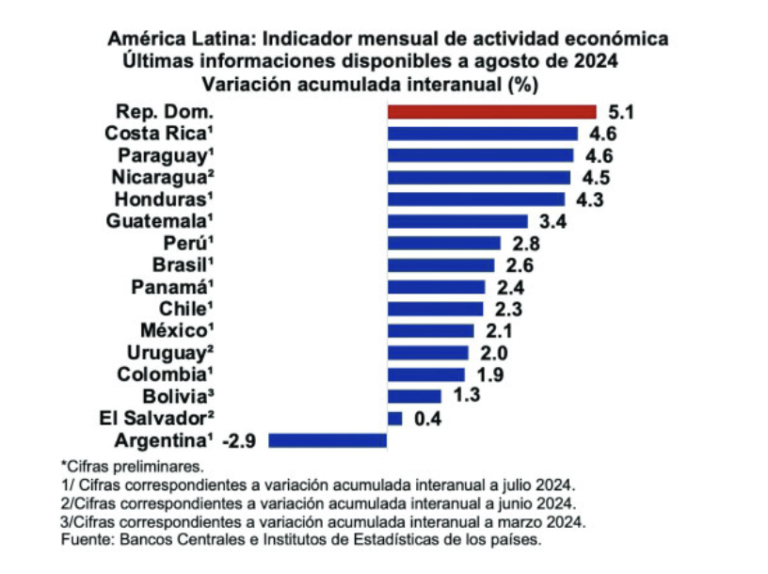ECLAC raised its growth estimate for Latin America this year to 2.2%.
The Economic Commission for Latin America and the Caribbean (ECLAC) reduced its growth estimate for the Dominican economy in 2023 by 0.6 percentage points about its September estimate, bringing it to 3.1%.
On the other hand, it increased its forecast to 4.1% for next year against its September forecast of 3%.
The estimate of 3.1% growth for 2023 is higher than the one made at the beginning of December by the governor of the Central Bank of the Dominican Republic, Héctor Valdez Albizu, whose estimate was for around 2.5%.
Updated GDP growth projections for 2023-2024
Preliminary Overview of the Economies of Latin America and the Caribbean, December 2023. Central America includes Cuba, Haiti, and the Dominican Republic.
Regional projection rises, but it comes with a warning
ECLAC also raised its regional GDP growth projection for 2023 by 0.6% from 1.7%, estimated last September, to 2.2%, but warned of the risks of “maintaining a path of low growth”.
According to its last report of the year entitled “Preliminary Overview of the Economies of Latin America and the Caribbean, 2023”, the United Nations agency based in Santiago, Chile reckons that by 2024, growth will fall to 1.9%, meaning a slowdown in regional growth from the levels seen in 2022.
“It is necessary to scale up productive development policies with a focus on dynamic strategic sectors, promote policies to encourage public and private investment, and adapt the financing framework to enhance resource mobilization,” said ECLAC’s Executive Secretary, José Manuel Salazar-Xirinachs.
Although all subregions will show lower growth in 2023 compared to 2022, the report highlights the diversity that exists among the countries of the region.
According to the report the trend of low growth “will mean a slowdown in job creation and the persistence of informality and gender gaps, among other effects.”
Panama, Costa Rica, and Paraguay: the fastest-growing
- Panama (6.1%), Costa Rica (4.9%), Paraguay (4.5 %), Mexico (3.6%) Guatemala (3.4% and the Caribbean islands (excluding Guyana) (3.4 %) will lead economic growth this year.
- Followed by Nicaragua (3.3%), Honduras (3.3%), and the Dominican Republic (3.1%).
- In the middle of the estimation table are Venezuela (3%) Brazil (3%), El Salvador 2.3%, Bolivia (2.2%), Ecuador (1.9%), and Cuba (1.5%).
- Bringing up the rear are Uruguay (1%), Colombia (0.9%), Peru (0.3%) and Chile (0.1%).
- Haiti (-1.8%) and Argentina (-2.5%) will decrease this year, according to the United Nations agency.
Latin America, the most unequal region in the world and the most affected by the pandemic, grew by 6.9% in 2021, a rebound after the 6.8% plunge recorded in 2020, the largest recession in 120 years.
The regional slowdown began in the second half of 2022, which closed with an estimated growth of 3.7%.
Falling Inflation
In 2023, ECLAC expects the region’s median inflation to fall to 3.8%, much lower than the 8.2% recorded in 2022, while in 2024 it should be 3.2%.
“Although inflation has decreased, interest rates in the main developed economies have not fallen, so financing costs have remained at elevated levels throughout the year and are expected to remain so for the next few years,” the agency said.
Employment Overview
As to employment, the agency forecasts that the number of employed people will have grown by 1.4%, which is a reduction of four percentage points compared to the 5.4% recorded in 2022.
“This lower job creation rate will extend into 2024 when the number of employed people is projected to grow by 1%,” he added.
Source:


